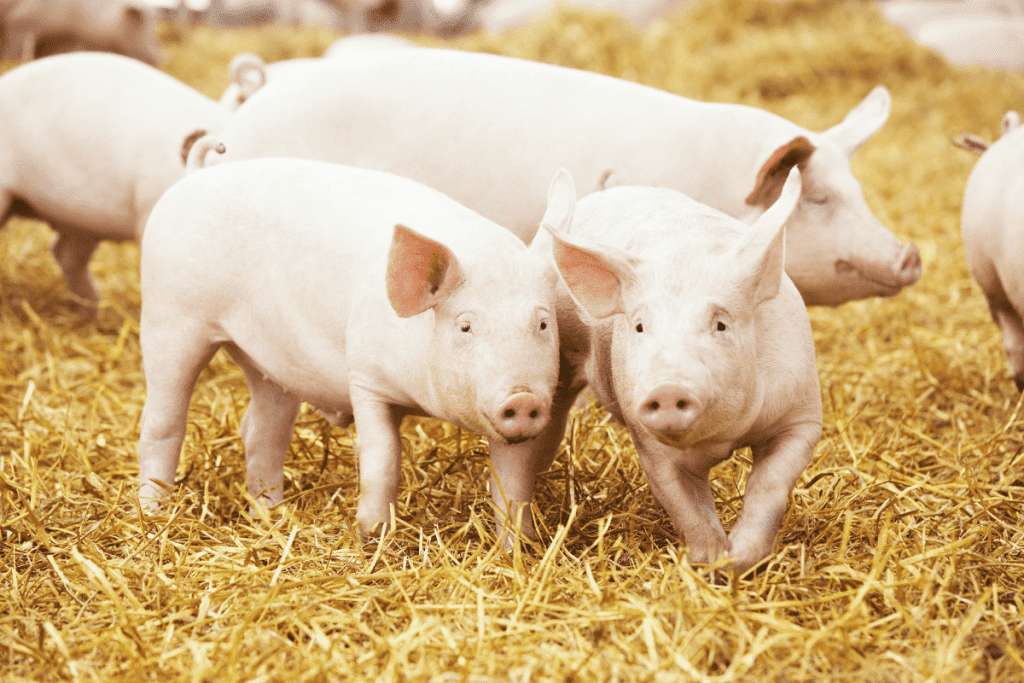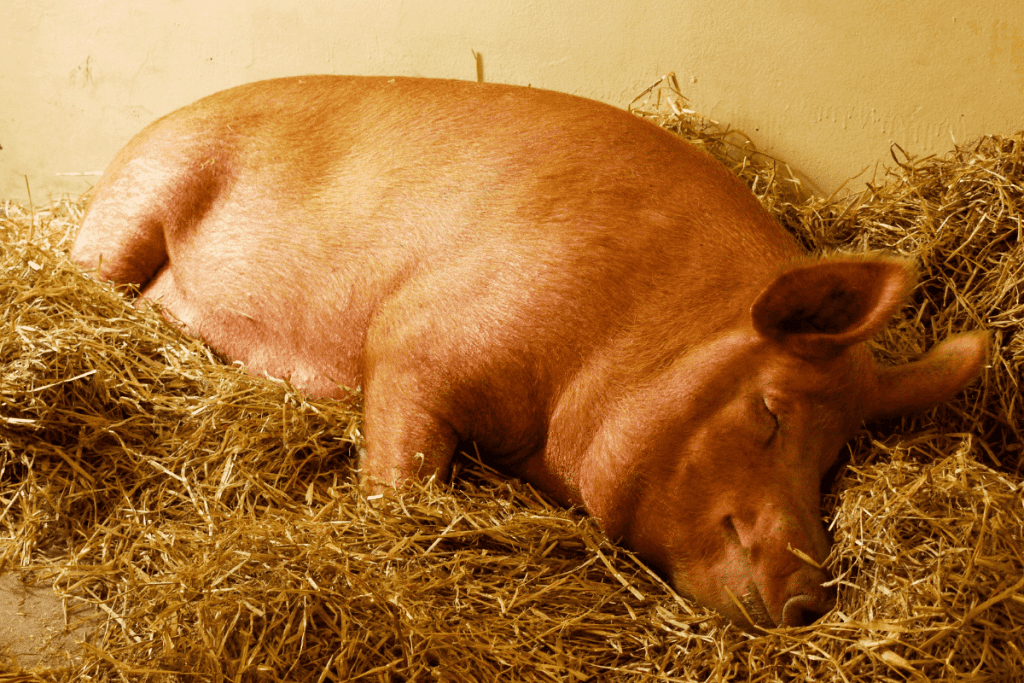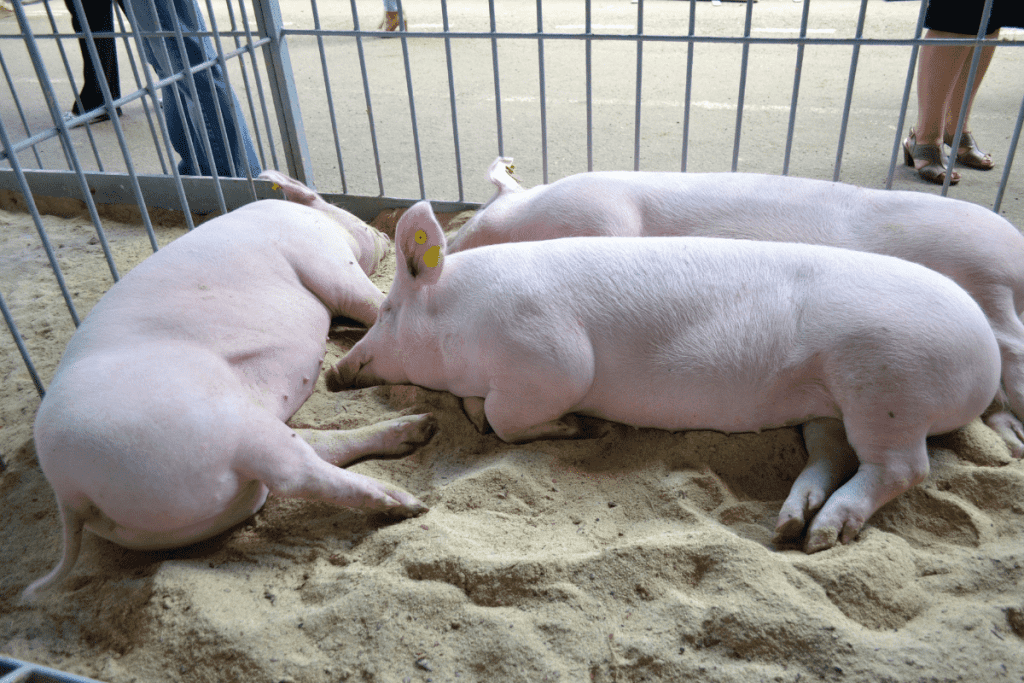If you are new to keeping pigs or looking for a way to improve the quality of life of your existing pigs, you may wonder what is the best bedding for pigs.
There are quite a few materials suitable for bedding for pigs.
They are not too picky and enjoy spreading the various organic materials.
Whether you are keeping feeder pigs or pet pigs, their health and happiness help to make things easier for you.
There are many different options for keeping pigs happy.
Straw is the best bedding for pigs. It is the most comfortable material. It is also the most absorbent. Pigs with straw beddings tend to be happier and calmer than those without bedding. Straw also helps to keep their environment dry and comfortable.
There is quite a bit needed to provide an adequate and suitable environment for pigs.
Studies show how healthy and happy pigs tend to be easier to handle and even produce more meat.
We’ll let you know everything about bedding options for pigs and why straw is the best option.

Table of Contents
ToggleWhat Is The Best Bedding For Pigs?
Choosing from the plentiful options of bedding types for pigs is overwhelming at times.
Most of us farmers want to keep our pigs as healthy and happy as possible.
Happy and healthy pigs tend to have better dispositions and are less likely to fight each other.
With all this being said, what is the best bedding for pigs?
Most agree straw is the best bedding for pigs.
It is considered to be the softest and most absorbent option to use.
It is also the most popular choice for bedding.
You may wonder why absorbency and softness are so important for bedding.
Having absorbent bedding keeps their environment cleaner and dryer.
This helps prevent skin conditions and other adverse health conditions caused by wet bedding.
The softness helps to keep pigs more comfortable.
Once you put the straw in the pigpen, you’ll undoubtedly notice how enthusiastically your pigs play with the bedding and burrow into it to make themselves as comfortable as possible.
There are other good options for bedding.
Many pig farmers choose whichever bedding is cheapest and most convenient based on their locations.
Certain parts of the country have varying costs for straw, hay, wood shavings, leaves, and other bedding material.
While straw is the best bedding option for pigs, choosing from one of the other safe materials is better than leaving your pigs with no bedding.
Check out our guide on the cost of owning pigs.
Why Is Bedding Important?
Some farmers may wonder why bedding is so important.
This may be especially true if you are raising feeder pigs.
Those who keep pigs as pets undoubtedly plan to spoil them in any way possible.
However, it is just as important to provide bedding for your feeder pigs.
Raising pigs for meat production is quite the undertaking. Sometimes these pigs fight by tail-biting.
Pigs tend to tail-bite and fight when they are unhappy or overcrowded.
They get irritable and take it out on each other.
Some pig farmers remove the temptation through the process of tail-docking, which is a surgery to remove or shorten the pigtails.
Studies have shown how cleaning bedding helps to keep pigs happier in smaller enclosures.
Even if you raise feeder pigs, bedding is a great way to keep them happy while they grow to market age.
Others also report how bedding helps their pigs gain more weight than those raised without any bedding.
The added comfort likely reduces the stress and allows them to fatten up more which will get you a better price when it comes time to sell their meat.
Bedding also provides a great source of stimulation and entertainment for your pigs.
Pigs are very intelligent and often have a lot of energy.
If there is nothing to do, they lie around and get depressed.
Providing bedding for them to push around and snuggle up helps stimulate them and get some of the excess energy out.
We recommend putting a full bale of straw in the pen and seeing how quickly your pigs spread it.
You’ll also see how much fun they have doing it.
For more helpful info on caring for pigs, check out our complete guide at the link.
Alternative Bedding Options For Pigs

While straw bedding is the best option for your pigpen, there are other options.
It’s good to know other materials for pig bedding as straw tends to be very expensive in certain areas.
The price of straw may also fluctuate throughout the seasons based on availability.
If you plan to keep your pigs over the winter, there might be variations in pricing for each type of bedding.
Make sure to check prices on your choice of bedding and see which option works best for you.
There are a few different types of straw types suitable for pigs, including:
- Wheat straw
- Oat straw
- Barley straw
- Rye straw
- Bean straw
Wood Shavings
Wood chips or shavings are excellent options for comfy bedding.
One thing to keep in mind is how many wood chips you need to sufficiently fill a pigpen.
For wood shavings to work as bedding, they need to be part of a deep bedding type system.
We recommend at least 1’ foot of depth for wood chips.
Your pigs will have fun carrying around the wood chips and spreading them around the pigpen.
There are some wood types unacceptable for pigs.
The main concern is cedarwood shavings which are toxic to many animals, including pigs.
The oils in the wood are not good for the pigs to digest, and, as any pig owner knows, your pigs will undoubtedly taste their bedding.
Some people prefer to use wood shavings over wood chips.
The shavings tend to be softer and easier on their feet and skin.
Some farmers do not like to use any wood products, especially if they are excessively dry and dusty.
Sometimes there is sawdust mixed in with the coarse wood shavings or chips.
Make sure your bedding material is not too dusty.
When pigs inhale too much dust, they suffer from coughing fits and respiratory issues.
Wood shavings and chips are usually cheap or free, depending on your location.
Many farmers succeed by reaching out to tree trimming companies and asking for leftover wood chips and shavings.
If you have any trees or limbs needing removal on your property, we highly recommend asking the company to leave the wood chips behind.
This gives you a free source of bedding for your pigs.
While they may not be as absorbent or soft as straw, it is still an excellent option.
It is possible to increase the absorbency by making sure your wood chip pile is covered with a tarp to keep it from getting overly wet.
Leaves
Another free option for bedding is leaves.
This is usually only available in the fall in most areas, but they are abundant when they come.
Leaves are very easy to spread around the pen.
Pigs will appreciate a big pile of leaves to romp around in.
They tend to spread them out on their own to make comfy spots to sleep and lounge around in.
If you keep your pigs year-round, using the autumn leaves will help to cut down on the costs of other more expensive forms of bedding.
Leaves are very fluffy and require a larger volume, so you’ll have to routinely add more to the pigpen to keep it soft enough.
It may help to supplement straw with the fallen leaves as the leaves tend to be reduced to nothing once they are crumbled.
Raking up leaves is a bit of a chore in the fall, but it’s a bit more motivating to do when you think of how much you’ll be saving on bedding for your pigpen.
If you are a large property, chances are you have enough access to leaves where you won’t need to outsource them.
We recommend reaching out to various landscaping companies to see if they are getting rid of any of their leaves for free.
For the most part, we don’t recommend spending money on bags of leaves as it usually is not worth it.
Leaves don’t last very long under the playful hooves of pigs which may make it a waste of money.
It is better to spend it on better options of bedding like straw.
Old Hay
Old hay is a great option for pig bedding.
It is fairly absorbent, and it tends to be less expensive than straw.
Some people opt for hay when the price of straw gets too expensive.
Hay works very well for absorbency and comfortable bedding.
Although it may not look as aesthetically appealing as straw, hay works very well for bedding.
Hay is usually very affordable as well as accessible in many areas.
Pigs also tend to love the process of scavenging around in the hay to see if there is anything left behind for them to eat.
Hay is also very renewable and composts easily.
Combined with the manure from the pigs, soiled hay from a pigpen makes a great start for a compost pile.
For livestock farmers keeping other farm animals, you may end up with leftover hay before bringing the animals to pasture.
If this is the case, use it in your pigpen to ensure you are not wasting any money on materials.
Pine Straw
Pine straw is the most accessible and affordable option for pig bedding in some locations.
This material works very well and is easy to spread.
Often it comes packed in the same way as straw in a brick-shaped bale.
Putting the whole bale of pine shavings into the pigpen provides an excellent source of fun, stimulation, and entertainment for your pigs.
They will enjoy breaking apart the bale of pine shavings and distributing the pine straw around their habitat.
Choosing A Pig Bedding Option

Choosing a bedding option often comes down to personal preference.
There are some types of bedding you want to avoid completely for your pigs.
There are some unsafe materials to avoid in the pigpen.
When choosing a bedding option, you want to prioritize some key factors.
Whatever material you choose needs to hit a few criteria:
- The bedding material should have a soft texture to provide comfort and padding for skin and pads. It should also be deep enough, so your pigs have enough material to feel cushioned when they lay down on it.
- The bedding material should be absorbent. One of the main functions of the bedding is to keep the pigpen dry. If too much manure or urine builds up in any area, the damp bedding creates an uncomfortable and unsanitary environment for your pigs. Using an absorbent material allows the pigs to live in a dry environment and makes it easier to clean out manure and lay down new bedding.
- The bedding material should be safe for the pigs to eat. Pigs will taste test just about anything they find in their environment. Make sure the bedding is safe for the pigs to ingest, as they are more than likely to gnaw on it a bit.
Do My Pigs Need Bedding?
Some people wonder if they need pig bedding material.
It is a big expense, and those looking to get the most return on their feeder pigs may wonder if it is necessary.
Despite the obvious benefits of bedding, there are some negative possibilities to keep in mind.
Most of these come down to sanitary conditions.
Extra Cost
Bedding is an added expense, especially if raising feeder pigs for meat production.
Studies show how pigs with bedding tend to weigh more than those who don’t once the market time comes around.
Those looking to save the most money should compare the cost of bedding against the potential extra money they may get from the extra weight.
Related: Best pig breeds for meat on a small farm
Risk Of Disease
Pigs tend to produce a lot of manure.
The excrement gets stuck into the bedding.
If the pigpen is not cleaned regularly, this may lead to diseases, viruses, and bacteria growth.
If weather conditions reach hot and humid climates, this happening is more likely.
There is also a risk of introducing outside bacteria and fungi by purchasing straw, hay, or wood shavings.
It is hard to tell what bacteria you bring on your pigs’ bedding.
This is another thing to consider when deciding whether or not to provide bedding for your pigs.
How useful was this post?
Click on a star to rate it!
We are sorry that this post was not useful for you!
Let us improve this post!
Tell us how we can improve this post?
